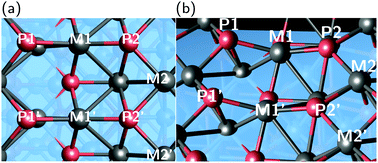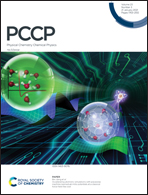First-principles investigation of the hydrogen evolution reaction of transition metal phosphides CrP, MnP, FeP, CoP, and NiP†
Abstract
We comprehensively investigated the hydrogen evolution reaction (HER) activity of a series of transition metal phosphides (MPs) (M = Cr, Mn, Fe, Co, and Ni) using first-principles calculations. The free energy difference was calculated for possible sites on the surface to pinpoint the reactive sites and the associated catalytic activities. We found that the chemical properties of these considered MPs are different from those of WP, including CrP which has the same electronic configuration as WP but was shown not to be a good electrocatalyst. Different reactive sites other than WP were predicted, and notably, unlike WP, phosphorus can participate/catalyze the HER on the considered MP. Among these MPs, there are more active sites on FeP, CoP, and NiP than CrP and MnP. Our electronic structure analysis suggests that the spin polarization is critical in determining the hydrogen adsorption and hence the HER performance. We further explored the HER of metal- or phosphorus-deficit MPs, as samples can be grown under different conditions. In particular, phosphorus-deficit FeP, CoP, and NiP were found to have enhanced HER performance, with either better catalytic activities or more active sites. Therefore, we proposed that controlling of these defects can be an effective approach to tune the HER catalytic ability of these MPs. It can serve as the design principle to synthesize new MP based electrocatalysts.



 Please wait while we load your content...
Please wait while we load your content...